+ Open data
Open data
- Basic information
Basic information
| Entry | Database: PDB / ID: 7ccs | ||||||
|---|---|---|---|---|---|---|---|
| Title | Consensus mutated xCT-CD98hc complex | ||||||
 Components Components |
| ||||||
 Keywords Keywords | TRANSPORT PROTEIN / Transporter / membrane protein / complex | ||||||
| Function / homology |  Function and homology information Function and homology informationcystine:glutamate antiporter activity / regulation of neutrophil apoptotic process / L-kynurenine transmembrane transport / L-kynurenine transmembrane transporter activity / regulation of cysteine metabolic process / regulation of glutathione biosynthetic process / regulation of glutamate metabolic process / regulation of melanin biosynthetic process / regulation of AMPA glutamate receptor clustering / L-cystine transport ...cystine:glutamate antiporter activity / regulation of neutrophil apoptotic process / L-kynurenine transmembrane transport / L-kynurenine transmembrane transporter activity / regulation of cysteine metabolic process / regulation of glutathione biosynthetic process / regulation of glutamate metabolic process / regulation of melanin biosynthetic process / regulation of AMPA glutamate receptor clustering / L-cystine transport / dipeptide import across plasma membrane / apical pole of neuron / tyrosine transport / L-histidine transport / amino acid transport complex / L-leucine import across plasma membrane / L-alanine transmembrane transporter activity / L-alanine import across plasma membrane / Defective SLC7A7 causes lysinuric protein intolerance (LPI) / aromatic amino acid transmembrane transporter activity / phenylalanine transport / methionine transport / L-leucine transmembrane transporter activity / amino acid transmembrane transport / isoleucine transport / valine transport / regulation of protein transport / proline transport / L-amino acid transmembrane transporter activity / L-leucine transport / L-glutamate transmembrane transport / thyroid hormone transport / glutathione transmembrane transport / regulation of cellular response to oxidative stress / intracellular glutamate homeostasis / ventricular system development / L-glutamate import across plasma membrane / neutral L-amino acid transmembrane transporter activity / striatum development / Tryptophan catabolism / exogenous protein binding / Amino acid transport across the plasma membrane / limb development / anchoring junction / response to redox state / Basigin interactions / NFE2L2 regulating anti-oxidant/detoxification enzymes / lung alveolus development / astrocyte projection / negative regulation of ferroptosis / microvillus membrane / regulation of synapse organization / response to exogenous dsRNA / adult behavior / amino acid transport / tryptophan transport / glutathione metabolic process / basal plasma membrane / brush border membrane / visual learning / modulation of chemical synaptic transmission / platelet aggregation / response to toxic substance / apical part of cell / calcium ion transport / melanosome / regulation of cell population proliferation / double-stranded RNA binding / virus receptor activity / cellular response to oxidative stress / basolateral plasma membrane / carbohydrate metabolic process / apical plasma membrane / cadherin binding / protein heterodimerization activity / lysosomal membrane / synapse / symbiont entry into host cell / cell surface / protein homodimerization activity / RNA binding / extracellular exosome / nucleoplasm / membrane / plasma membrane Similarity search - Function | ||||||
| Biological species |  Homo sapiens (human) Homo sapiens (human) | ||||||
| Method | ELECTRON MICROSCOPY / single particle reconstruction / cryo EM / Resolution: 6.2 Å | ||||||
 Authors Authors | Oda, K. / Lee, Y. / Takemoto, M. / Yamashita, K. / Nishizawa, T. / Nureki, O. | ||||||
 Citation Citation |  Journal: Protein Sci / Year: 2020 Journal: Protein Sci / Year: 2020Title: Consensus mutagenesis approach improves the thermal stability of system x transporter, xCT, and enables cryo-EM analyses. Authors: Kazumasa Oda / Yongchan Lee / Pattama Wiriyasermkul / Yoko Tanaka / Mizuki Takemoto / Keitaro Yamashita / Shushi Nagamori / Tomohiro Nishizawa / Osamu Nureki /   Abstract: System x is an amino acid antiporter that imports L-cystine into cells and exports intracellular L-glutamate, at a 1:1 ratio. As L-cystine is an essential precursor for glutathione synthesis, system ...System x is an amino acid antiporter that imports L-cystine into cells and exports intracellular L-glutamate, at a 1:1 ratio. As L-cystine is an essential precursor for glutathione synthesis, system x supports tumor cell growth through glutathione-based oxidative stress resistance and is considered as a potential therapeutic target for cancer treatment. System x consists of two subunits, the light chain subunit SLC7A11 (xCT) and the heavy chain subunit SLC3A2 (also known as CD98hc or 4F2hc), which are linked by a conserved disulfide bridge. Although the recent structures of another SLC7 member, L-type amino acid transporter 1 (LAT1) in complex with CD98hc, have provided the structural basis toward understanding the amino acid transport mechanism, the detailed molecular mechanism of xCT remains unknown. To revealthe molecular mechanism, we performed single-particle analyses of the xCT-CD98hc complex. As wild-type xCT-CD98hc displayed poor stability and could not be purified to homogeneity, we applied a consensus mutagenesis approach to xCT. The consensus mutated construct exhibited increased stability as compared to the wild-type, and enabled the cryoelectron microscopy (cryo-EM) map to be obtained at 6.2 Å resolution by single-particle analysis. The cryo-EM map revealed sufficient electron density to assign secondary structures. In the xCT structure, the hash and arm domains are well resolved, whereas the bundle domain shows some flexibility. CD98hc is positioned next to the xCT transmembrane domain. This study provides the structural basis of xCT, and our consensus-based strategy could represent a good choice toward solving unstable protein structures. | ||||||
| History |
|
- Structure visualization
Structure visualization
| Movie |
 Movie viewer Movie viewer |
|---|---|
| Structure viewer | Molecule:  Molmil Molmil Jmol/JSmol Jmol/JSmol |
- Downloads & links
Downloads & links
- Download
Download
| PDBx/mmCIF format |  7ccs.cif.gz 7ccs.cif.gz | 176.9 KB | Display |  PDBx/mmCIF format PDBx/mmCIF format |
|---|---|---|---|---|
| PDB format |  pdb7ccs.ent.gz pdb7ccs.ent.gz | 138.6 KB | Display |  PDB format PDB format |
| PDBx/mmJSON format |  7ccs.json.gz 7ccs.json.gz | Tree view |  PDBx/mmJSON format PDBx/mmJSON format | |
| Others |  Other downloads Other downloads |
-Validation report
| Arichive directory |  https://data.pdbj.org/pub/pdb/validation_reports/cc/7ccs https://data.pdbj.org/pub/pdb/validation_reports/cc/7ccs ftp://data.pdbj.org/pub/pdb/validation_reports/cc/7ccs ftp://data.pdbj.org/pub/pdb/validation_reports/cc/7ccs | HTTPS FTP |
|---|
-Related structure data
| Related structure data |  30341MC M: map data used to model this data C: citing same article ( |
|---|---|
| Similar structure data |
- Links
Links
- Assembly
Assembly
| Deposited unit | 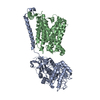
|
|---|---|
| 1 |
|
- Components
Components
| #1: Protein | Mass: 68069.625 Da / Num. of mol.: 1 Source method: isolated from a genetically manipulated source Source: (gene. exp.)  Homo sapiens (human) / Gene: SLC3A2, MDU1 / Cell line (production host): HEK293SGnTI- / Production host: Homo sapiens (human) / Gene: SLC3A2, MDU1 / Cell line (production host): HEK293SGnTI- / Production host:  Homo sapiens (human) / References: UniProt: P08195 Homo sapiens (human) / References: UniProt: P08195 |
|---|---|
| #2: Protein | Mass: 55933.852 Da / Num. of mol.: 1 Source method: isolated from a genetically manipulated source Source: (gene. exp.)  Homo sapiens (human) / Gene: SLC7A11 / Cell line (production host): HEK293SGnTI- / Production host: Homo sapiens (human) / Gene: SLC7A11 / Cell line (production host): HEK293SGnTI- / Production host:  Homo sapiens (human) / References: UniProt: Q9UPY5*PLUS Homo sapiens (human) / References: UniProt: Q9UPY5*PLUS |
| Has protein modification | Y |
-Experimental details
-Experiment
| Experiment | Method: ELECTRON MICROSCOPY |
|---|---|
| EM experiment | Aggregation state: PARTICLE / 3D reconstruction method: single particle reconstruction |
- Sample preparation
Sample preparation
| Component | Name: Consensus mutated xCT-CD98hc complex / Type: COMPLEX / Entity ID: all / Source: RECOMBINANT |
|---|---|
| Molecular weight | Value: 0.12 MDa / Experimental value: YES |
| Source (natural) | Organism:  Homo sapiens (human) Homo sapiens (human) |
| Source (recombinant) | Organism:  Homo sapiens (human) Homo sapiens (human) |
| Buffer solution | pH: 8 |
| Specimen | Embedding applied: NO / Shadowing applied: NO / Staining applied: NO / Vitrification applied: YES |
| Specimen support | Grid material: COPPER/RHODIUM / Grid mesh size: 300 divisions/in. / Grid type: Quantifoil R1.2/1.3 |
| Vitrification | Cryogen name: ETHANE |
- Electron microscopy imaging
Electron microscopy imaging
| Experimental equipment |  Model: Titan Krios / Image courtesy: FEI Company |
|---|---|
| Microscopy | Model: FEI TITAN KRIOS |
| Electron gun | Electron source:  FIELD EMISSION GUN / Accelerating voltage: 300 kV / Illumination mode: FLOOD BEAM FIELD EMISSION GUN / Accelerating voltage: 300 kV / Illumination mode: FLOOD BEAM |
| Electron lens | Mode: BRIGHT FIELD |
| Image recording | Electron dose: 49.76 e/Å2 / Film or detector model: GATAN K3 (6k x 4k) |
- Processing
Processing
| CTF correction | Type: PHASE FLIPPING AND AMPLITUDE CORRECTION |
|---|---|
| 3D reconstruction | Resolution: 6.2 Å / Resolution method: FSC 0.143 CUT-OFF / Num. of particles: 86395 Details: This pdb entry contains an issue about peptide linkage (bond outlier). Residues GLU A 213 and LEU A 214 that are next to each other are not properly linked: distance between C and N is 3.35. ...Details: This pdb entry contains an issue about peptide linkage (bond outlier). Residues GLU A 213 and LEU A 214 that are next to each other are not properly linked: distance between C and N is 3.35. This was introduced upon the fitting of the homology model into the low resolution cryo-EM map by using Rosetta. The model has not undergone any further structure refinement. Symmetry type: POINT |
 Movie
Movie Controller
Controller



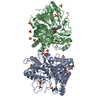

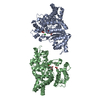


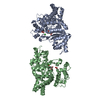
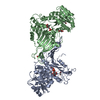



 PDBj
PDBj



